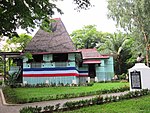Eulogio Amang Rodriguez Institute of Science and Technology
The Eulogio "Amang" Rodriguez Institute of Science and Technology (commonly referred to as EARIST; Filipino: Kolehiyong Eulogio "Amang" Rodriguez sa Agham at Teknolohiya) is a public college in Santa Mesa, Manila in the Philippines. It was named after Eulogio Rodriguez, one of the longest serving senators in the country. Founded in 1945 as a vocational-technical high school, it has evolved into a full-fledged higher education institution offering undergraduate and postgraduate degree programs by virtue of the Republic Act 6595. EARIST has a Level II Status for its 14 degree programs awarded by the Accrediting Agency of Chartered Colleges and Universities in the Philippines (AACCUP). It was also rated Level II based on CHED-DBM-PASUC Leveling Evaluation. With approximately 15,000 students, it has eight colleges, graduate school, and a satellite campus in Cavite. The institute is envisioned to develop its students in the fields of trades, business, arts, science, and technology education..
Excerpt from the Wikipedia article Eulogio Amang Rodriguez Institute of Science and Technology (License: CC BY-SA 3.0, Authors).Eulogio Amang Rodriguez Institute of Science and Technology
Mabini Flyover, Manila Santa Mesa (Sixth District)
Geographical coordinates (GPS) Address Website External links Nearby Places Show on map
Geographical coordinates (GPS)
| Latitude | Longitude |
|---|---|
| N 14.59907 ° | E 121.00116 ° |
Address
Eulogio "Amang" Rodriguez Institute of Science and Technology
Mabini Flyover
1213 Manila, Santa Mesa (Sixth District)
Philippines
Open on Google Maps










